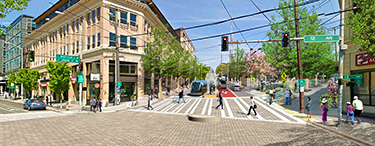|
Subscribe / Renew |
|
|
Contact Us |
|
| ► Subscribe to our Free Weekly Newsletter | |
| home | Welcome, sign in or click here to subscribe. | login |
Architecture & Engineering
| |
July 28, 2016
Madison BRT line would cost $120M
The Seattle Department of Transportation will hold a series of open houses in early August to update the community on plans for a $120 million bus rapid transit corridor along Madison Street between downtown and Madison Valley.
The proposed 2.4-mile line would run from First Avenue to Martin Luther King Jr. Way South. Eastbound buses would use Spring Street downtown, where Madison runs one way in the other direction.
Open houses are scheduled over the next two weeks:
• 5-7 p.m. Aug. 3 at Seattle University, 914 E. Jefferson St., in Campion Ballroom
• 11 a.m.-1 p.m. Aug. 4 at Town Hall Seattle, 1119 Eighth Ave., downstairs
• 5-7 p.m. Aug. 9 at Meredith Mathews East Madison YMCA, 1700 23rd Ave.
SDOT forecasts ridership along the corridor will grow from 12,000 average weekday boardings to 17,000 by 2035. But current Metro bus service takes 67 percent longer than driving, and more than a quarter of the trips on routes 11 and 12 run more than five minutes late.
The bus rapid transit system would provide fast, high-frequency, all-day service, SDOT says.
On weekdays during peak hours, buses would arrive every six minutes. Buses would travel in dedicated lanes on 65 percent of the route, and would receive signal priority. East of 18th Avenue, buses would drive in mixed traffic.
SDOT expects the changes would improve eastbound travel times by 40 percent, from 16.3 minutes to 9.8 minutes between First and 23rd avenues. Car drivers would see an increase in their travel times by 3.6 minutes over the same distance.
Westbound travel times for buses would also improve, but not as dramatically, from 12.1 minutes to around eight minutes from 20th to First avenues.
The proposal calls for 11 pairs of stations, including some located on a center median. Buses would be electric trolleys with doors that open on both sides.
Stations would be located on a raised platform that allows riders to enter without climbing steps. Fares would be paid on the platform.
SDOT said that the Madison corridor was not a candidate for light rail because of steep hills.
Only $15 million in funding has been secured so far. Additional funding could come from the upcoming Sound Transit 3 ballot measure and federal grants.
Design of the Madison bus rapid transit line is scheduled to be 30 percent complete this fall.
Construction is expected to begin in 2018, and the line would open in late 2019.
The line is one of seven bus rapid transit corridors the city plans to add by 2025.



